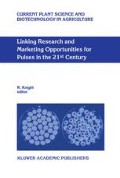Abstract
India is the world’s largest producer and consumer of pulses. The Indian population today stands close to 950 million people and the growth rate is 2.5% a year. A large segment of the population is vegetarian and pulses are the best source of protein for them. Today the requirement for pulses is about 17 million tonnes but production is 13 to 14 million tonnes leaving a gap of 3 to 4 million tonnes. This large gap between demand and supply is due to stagnant production, drought or a poor-crop as happened this year (1997) for Tyson chickpeas. India has imported about 200 thousand tonnes of Tyson chickpeas from Australia this calendar year and expects another 70 thousand tonnes to come from Australia between September and December 1997. Demand for pulses in India is also sometimes affected by their high price, as consumption is price sensitive. If the price of a particular pulse is high, its consumption falls and is supplemented by vegetables or other lower priced pulses.
Preview
Unable to display preview. Download preview PDF.
References
Anonymous, 1994. Seventh Five Year Development Plan. Turkish Republic, State Planning Organization. Ankara.
Anonymous, 1997. Akdeniz Exporters Unions Annual Reports. Mersin.
Bayaner, A., Uzunlu, V., Keatinge, J.D.H., and Tutwiler, R. 1993. Highland Regional Program. A Collaborative Research Project between TARM and ICARDA. Central Research Institute for Field Crops. Ankara.
Bayaner, A. 1996. Post Doctorate Study Report. Department of Agricultural Economics and Management. Reading University.
Blain, H.L. 1988. In: World Crops; Cool Season Food Legumes, pp 501-511 (ed R.J. Summerfield). Kluwer Academic Publishers.
Dickey, D.A. and Fuller, W.A. 1979. Journal of American Statistical Association, 74(366): 427–431.
Dickey, D.A. and Fuller, W.A. 1981. Econometrica, 49(4): 1057–1072.
Hallam, D., Machado, F. and Rapsomanikis, G. 1992. Journal of Agricultural Economics, 43(1): 29–37.
Hendry, D.F. 1986. Oxford Bulletin of Economics and Statistics 48 201–212.
Keatinge, J.D.H. 1994.. Journal of Economics, Agriculture and Environment (MEDIT) 5, 19–23.
Kusmenoglu, I. and Bayaner, Ahmet. 1995 In. Improving Production and Utilization of Grain Legumes. Proceedings of Second European Conference on Grain Legumes. AEP. 9–13 July, Copenhagen-Denmark.
Oram, P.A. and Agcaoili, M. 1994. In: Expanding the Production and Use of Cool Season Food Legumes. pp 3-49 (eds F.J. Muehlbauer and W.J. Kaiser). Kluwer Academic Publishers.
Sargan, J.D. and Bhargave, A. 1983. Econometrica, 51(1): 153–174.
Sanjuan, A.I. and Gil, J.M. 1996. Presented at the EAAE Conference. 3–7 September 1996. Edinburgh.
SIS, 1992. Foreign Trade Statistics, Turkish Republic, Prime Ministry, State Institute of Statistics, No: 1615. Ankara.
SIS, 1994. Agricultural Structure and Production, Turkish Republic, Prime Ministry, State Institute of Statistics, Ankara.
SIS, 1995. Statistical Indicators, 1923–1995. Turkish Republic, Prime Ministry, State Institute of Statistics, No: 1883. Ankara.
Tekinel, O., Dinc, E., Erkan, O., Cevik, B., Tuzcu, O., and Saglamtimur, T. 1990. Cukurfova University Faculty of Agriculture GAP Agricultural Research and Development Project Final Report. GAP Publication, No: 33. Adana.
Author information
Authors and Affiliations
Editor information
Editors and Affiliations
Rights and permissions
Copyright information
© 2000 Springer Science+Business Media Dordrecht
About this chapter
Cite this chapter
Kothari, B. (2000). The impact of production from the Indian sub-continent on world trade in pulses. In: Knight, R. (eds) Linking Research and Marketing Opportunities for Pulses in the 21st Century. Current Plant Science and Biotechnology in Agriculture, vol 34. Springer, Dordrecht. https://doi.org/10.1007/978-94-011-4385-1_20
Download citation
DOI: https://doi.org/10.1007/978-94-011-4385-1_20
Publisher Name: Springer, Dordrecht
Print ISBN: 978-94-010-5884-1
Online ISBN: 978-94-011-4385-1
eBook Packages: Springer Book Archive

